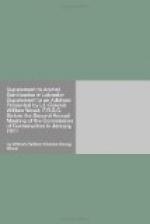over which these deer migrate, compared with
the comparatively small number of Indians—and
there is a steadily decreasing number—I
can hardly believe that there is much fear of
their ever exterminating these deer. Then,
could we possibly prevent these Indians from hunting
the deer wherever they meet them? I hardly
think we could. The barren-ground caribou
are not hunted to any extent by whites.
During the month of August, the Eskimo of the Ungava
peninsula, as well as those in Baffin island,
resort to certain fords, or narrows where these
caribou usually pass at the beginning of the
fall migration. They kill considerable numbers—rather
for the skins as clothing, than for food.
But the Eskimo are few in number, and I cannot conceive
that there is any fear of these caribou ever being
greatly reduced in number by these native hunters.
Any one who has ever met a herd of barren-ground
caribou, and seen the countless thousands of
them, could hardly conceive of their ever being
exterminated. Nor would they be if we had to
deal only with the native hunters. But, with our
experience of what happened to the buffalo when
the white man took up the slaughter, we must
take precaution in time.
Up to the present, very few white men have penetrated any distance into the interior of the Labrador peninsula, and I do not see that they are very likely to, in the near future. But we never can tell. A few years ago we would have said the same of the Yukon region, so that it would be a wise precaution to have set apart a considerable section of the Labrador, in the interior, as a sanctuary.... It would perhaps be better to have two regions set apart, one near the Saguenay country and another nearer the Atlantic coast. We have, however, to consider the fact that sanctuaries will be of no value unless they are well guarded.
In the case of the birds the conditions are bad; the destruction on the Labrador is horrible to contemplate. The outer islands were scoured by crews from foreign vessels, and whole loads of eggs carried off. There has not been much of this done in recent years. There can he no doubt that, if certain of the larger and less inhabited islands were set apart, and carefully protected, the birds would return to them. I believe that owing to the constant way in which the birds—eider ducks, certain of the divers, gulls, &c., were disturbed, on their natural and original nesting places, they have changed their habits; and, instead of nesting on the islands and by the sea, they have moved to the shores of the interior lakes. You see flocks of young birds in the fall; they have come from the interior, as they were not hatched out on the islands as they used to be.
The destruction of geese and curlew does not take place on the Labrador. These birds are not disturbed on their nesting grounds; but, to the south and west when they are passing to their winter haunts. Geese are found feeding




